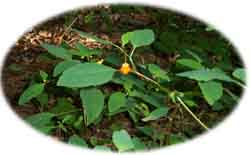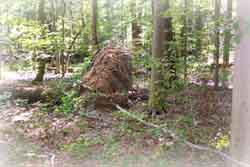Johnson Woods Boardwalk Trail
Ohio Department of Natural Resources, Division of Natural Areas and Preserves
Johnson Woods State Nature Preserve
Trail Location
Orrville, Ohio (Wayne County)
From Route 585, take Route 57 south. Turn East on Fox Lake Road. The parking lot is about a mile up on the north side of the road. The hiking trail is directly across the street from the parking lot.
Trail Summary

The orange flowered spotted touch-me-not(Impatiens capensis) is a common sight in these woods during the summer.
Length: 1.5 mile.
Duration: 45 Minutes
Surface: recycled plastic boardwalk.
Type: Loop.
Difficulty: easy
Accessibility: yes, but narrow.
Trail Description
This short hiking trail is located in an island of forest surrounded by rolling fields of corn and soybeans, picturesque farmsteads and newer residences. The 206 acre nature preserve is an old growth forest which was spared the axe when European settlers tamed the northeast Ohio landscape in their westward migrations. Some of the trees in this preserve are over 400 years old. The undisturbed forest along this hiking trail is a valuable classroom to learn about how a forest may develop in the absence of mankind's dominance. When you stand beneath the full summer canopy of these woods, the leafy roof is about 120 feet above the ground. The lowest branches on many of these trees are 50 feet up. You will quickly catch on to the fact that in this forest, as in the primeval forests of Ohio, the trees are dominant, not us.The ancient oaks that make up the bulk of this forest are in the neighborhood of 4 feet in diameter at breast height. The age and condition of these trees suggest that they are nearing the end of their natural lifespan. As you walk along the boardwalk, you will notice that some of the large oaks are declining, while the next smaller class of trees seems to be gaining prominence. These younger trees, mainly the smooth-barked Beech tree, are shade tolerant while oaks are not. This little factoid has big consequences for an old oak forest. Oak seedlings have a hard time living in the shade beneath the canopy. When the dominant trees in this forest die, they are most likely to be replaced by a beech or a maple, which are able to grow in the shade of the oaks above. Over the next hundred years or so, this forest will gradually undergo natural succession from an oak forest to a beech maple forest.

This recently fallen tree is an example of pit and mound topography in the making. The pit below the root ball of this fallen tree will hold water and provide amphibians with habitat for many springs to come.
As you hike along this trail, notice the fallen trees. Look at the base of the tree. There is often a large ball of roots holding an even larger ball of dirt which has been pulled up with the roots. Over time this ball of dirt will smooth out and become more like a mound. The place where the tree stood before it fell will have a small pit. This "pit and mound" topography is typical of an old growth forest. You know a forest is really old when large old trees are standing on the mounds left by previous generations of trees. This enhances forest diversity by creating lots of niches for different plant and animals to find what they need. For example, the pits next to fallen trees often develop into small "ponds" during the spring. These areas can support amphibian populations as well as providing water for mammals.
As you walk through this forest in spring, you may see as many as 65 species of flowers blooming. This very diverse forest floor community is largely intact because humans have not abused this forest the way many of our northeast Ohio woods have been abused. The forest does not appear to have been grazed in recent times, and has obviously never been row cropped. Additionally, white tailed deer do not appear to have impacted the forest to any great extent.
When the spring wildflowers retreat with the coming of the tree canopy and the shade it brings, other plants fill the voids. During the summer, you will see a variety of flowers blooming in these woods. Nettles, cardinal flower, and touch-me-nots are common along the boardwalk, especially in the more moist areas. You will also see a number of fern species, including sensitive fern, New York fern, wood fern, and rattlesnake fern.
Trail Rules
Rules are posted at a kiosk at the beginning of the trail. However you should be aware of some of these before going to the trail. Pets are not allowed. You must remain on the boardwalk at all times to avoid damaging this intact forest community. The park is closed after dark.
